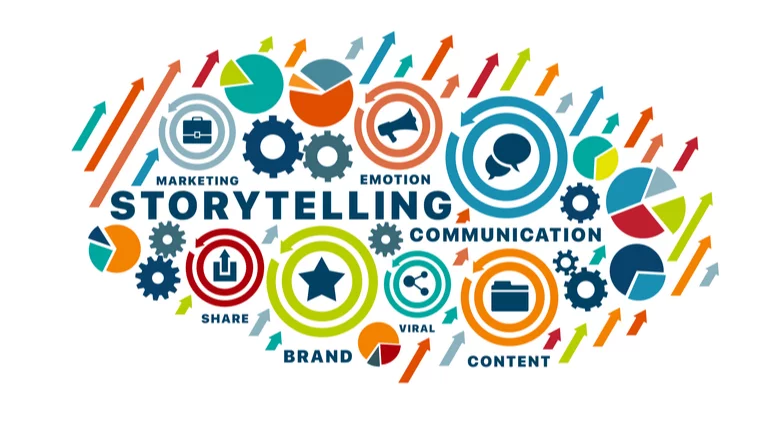The Power of Storytelling in Building Your Brand
I. Storytelling and Branding
– Sparsh Gandhi

A. What Is Storytelling?
Storytelling is the capacity of telling experiences, thoughts, and emotions using stories. Storytelling is not entertainment but a means through which an individual relates meaning to his audience by conveying messages and values. Storytelling in branding encompasses what one’s brand is all about, thereby making it relatable and memorable.
B. Significance of Storytelling in Branding
In a competitive market, brands have to learn how to differ from the competition. Storytelling is an effective way of emotionally connecting people with your audience. Using applicable stories connects brands with customers and hence gives them reason to remain loyal and buy from their company, a company that has values the majority can relate to. Storytelling can therefore convert a simple sale into a connection, which would be very important for creating brand loyalty over the long run.
C. History for Which Storytelling Will Be Used in Marketing
Historically, storytelling has been at the heart of all marketing. Whether it be ancient oral tradition or modern advertisement, stories have always been central to human conversation. Early brands like Coca-Cola and Nike exploited storytelling as a way to reach out personally to their audience, which is the paradigm of the current age of brand narratives. Stories now fill every aspect of marketing from advertisements to a social media campaign.
II. Components of Storytelling in Brands
A. Know Your Audience
Know your audience. Knowing the audience is essentially the heart of good storytelling. Companies must understand their customer demographics, psychological triggers, and preferences. From there, as a brand takes the time to research and understand their audience, their stories can be designed to make them more relatable and impactful.
B. Define What Matters at the Core of Your Brand
Core values are what give a brand the essence of storytelling. They communicate what a brand stands for and why it exists. Identifying these values not only helps in crafting messages but positions your brand uniquely in the marketplace.
C. Crafting a Compelling Narrative
A great story includes relatable characters, conflict, and resolution. Brands need to work to relate their audience through a story that resonates with their values, their desires, and their challenges. In other words, using authentic voices and situations that touch hearts and minds and really draw an audience into the brand’s journey.
III. Types of Brand Stories
A. Origin Stories
These origin stories mention the concept behind the creation of the brand along with the reasons and discomforts that led to its creation. These stories give credibility and show the true heart of the brand. Starbucks depicts the story vividly regarding how Starbucks originally began as a firm dealing with merely common coffee beans and over the years, how the concept has well-been clicked by the customers.
B. Customer Success Stories
It is the real experience of a customer who is happy, who is benefited from the offerings of the brand. Stories that validate what the brand has to offer create this feeling of community and belonging among the would-be clients. Testimonials and case studies or stories of transformation really do much for credibility.
C. Mission-Driven Stories
Mission-driven stories involve a brand having an active association with causes or values in society. Brands like Patagonia, known for their environmental activities, use these stories to connect with the value system of customers and give a deeper purpose other than profits. It creates a loyal customer fraternity that supports the efforts of this brand in serving more significant causes.
IV. Communication Channels
A. Social Media Channels
Social media portals are strong means of storytelling. By different formats such as posts, stories, and videos, brands can narrate, engage their audiences in real-time, and drive business through authenticity and interactivity to cultivate personal relationships between manufacturers and their customers.
B. Blogs and Websites
Blogs and websites allow for a lot more extensive storytelling. Articles, case studies, and brand stories provide room to elaborate on the vision behind a company’s purpose and mission. Such extended content allows for extensive interaction while serving as a repository of several stories that a visitor will be able to delve into during the visit.
C. Video Content and Podcasts
Storytelling is nowadays mainly used on video content and podcasts. The brands can hence easily work with emotions and engagement by using the audio and visual content. For example, it might be an efficient narrative if, like in the case of the show, there are behind the scenes or interviews with satisfied customers.
V. Storytelling Impact Measurement
A. Engagement metrics
Using metrics like likes, shares, and comments to measure the engagement of storytelling will help brands understand the sort of engagement going on among the audiences, thus helping them determine their success.
B. Conversion Rates
Tracking conversion rates is the other major measurement. In this case, as stories influence actions like subscribing to a newsletter, or making purchases-through its website-the brands will have an explicit view of how successful their stories are.
C. Long-term Loyalty Brand
Long-term loyalty brand is another significant measurement. Tracking how stories influence consumer actions such as subscribing to a brand’s newsletter, the purchase via its website will give brands an explicit view of how successful their stories are.
Ultimately, it is brand loyalty that will measure the stories. This will be how relevant a company’s story has been by looking into customer retention rates, repeating purchases, as well as telling their friends about it.
VI. Key Takeaways
A. Summary of Key Points
Branding storytelling has become the factor that allows companies to relate to their consumers on an emotional level, share values, and gives an idea about the position of the company in the market, allowing it to be differentiated from others.
Knowledge of the target audience and how to prepare a story worthwhile to them are exactly what form the successful brand storytelling process.
B. Evolution of Storytelling in the Branding Process
As markets evolve, so will the role of storytelling in brand development. Brands must remain agile, looking to new channels and methods of storytelling to allow for their survival.
C. Future Trends in Brand Storytelling
Future trends may include personalization and the use of artificial intelligence to create targeted narratives. Brands must accept technology, but in order to continue connecting with their audience, they must hold true to the authentic stories behind the brand.
VII. FAQs
A. How do I get started telling stories with my brand?
Start off defining your brand’s core values and getting to know your target audience. Now brainstorm possible stories that bridge your values to the experiences of your audience. Then think about different formats and channels you can use to share these stories with those audiences
B. What kinds of stories do my audiences respond to the most?
Generally, authentic stories that resonate are those which reflect our lives. In that regard, origin stories will normally capture people’s attention, whereas customer success stories will give customers real proof of a brand’s value. Mission-driven stories basically speak to consumers emotionally and do this by showing that the brand is adhering to certain value points.
C. How will I measure the success of my brand storytelling?
The success of these can be measured in the following ways: In particular, metrics like level of engagement, conversion rate, and other long-term loyal customers are to be considered. Each customer interaction should be studied along with sales data to know if your storytelling strategy is being effective.
